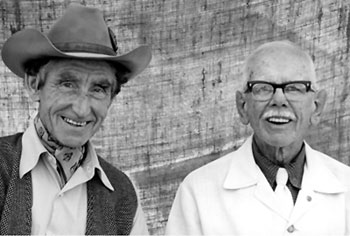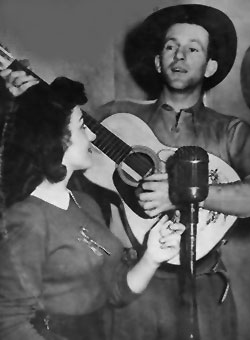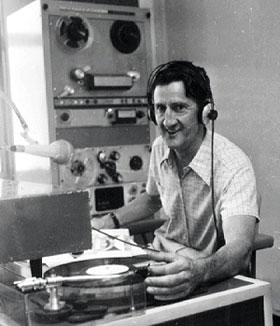A website dedicated to preserving and promoting the history of Australian |
 |
Country Music |
|
|
||
|
– Slim, Chronicler of the Bush A Tribute to The McKean Sisters ARCH KERR – PIONEER RECORD PRODUCER Australia's College of Country Music Brief History of the Golden Guitar Awards Country Music Capital Meets Music City History of the College of Country Music How Tamworth became Country Music Capital How the College of Country Music Works Narrative! Narrative! Narrative! Origins of the Tamworth Country Music Festival For more information Email info@historyofcountrymusic.com.au Disclaimer All matters relating to the conduct of this site remain under the total control of Max Ellis or his nominees who will endeavour to ensure the accuracy and balance of the content and proper conduct of the site but, subject to legal requirements, cannot be held responsible for any digression or non-compliance in respect of these matters. |
Arch Kerr Our pioneer recording producer Arch Kerr talks with John Minson.
Arch Kerr worked with and recorded "The Father Of Australian Country Music" Tex Morton and followed up by signing Buddy Williams, Smoky Dawson, Shirley Thoms and many other pioneer country music artists. His influence was immense and his artists respected him greatly. Slim Dusty, for instance, recalled that to him and the other artists, it was always Mister Kerr and that's what Slim still called him when he met Arch again after a 30 year interval! Arch Kerr had plenty of musical experience. He worked in a music warehouse from 1921, ran his own dance orchestra and played for the silent pictures; saxophone, clarinet and piano accordion were his popular instruments. From 1938, Arch worked as Sales Manager for the then Columbia Gramophone (Aust) Pty Ltd, an offshoot of Electric and Musical Industries, (later EMI) the English parent. Activities were centered on the factory at Homebush, NSW, which was the original Columbia site in Australia. When His Master's Voice closed their operation at Erskinville in Sydney, they transferred to Homebush, as did Parlophone. Arch Kerr left EMI in 1950. He was honoured for his contributions to the industry with a Golden Guitar in Tamworth in 1981 and he died in Toowoomba, Queensland in 1988. On March 2nd, 1980, John Minson and Max Ellis visited Arch at his home in Toowoomba and he talked on tape with John about the formative years of Australian country music. This is an edited transcript of that 2TM Hoedown interview. John: You're not generally regarded, historically anyway, in a sales situation. What was the association between sales managership and recording? Arch: Well, in those days, we didn't have artist and repertoire managers and producers; the sales manager did the lot. My work involved local recording, selecting the artist and the material to be recorded, the accompaniment to be used. Then I had to supervise the recording and pass them before they were processed. I also arranged the labels far them and nominated the number to be pressed. John: Did you record at the factory? Arch: Yes ... it's rather interesting to look back on that. In those days we couldn't get electric motors that would run at an accurate enough speed and we used the old weight motors. A big weight of lead on the end of a wire end it had to be wound up before the recording was made. The actual recording was cut on a slab of special wax about an inch-and-a-quarter thick, processed from there. John: These were of course just the one take? Arch: Oh no, no, no. We used to take and take and take until we got two good recordings. One was the "sub" one; that was the better of the two, then a "sub two" for emergencies. John: In order to attain the standard of recording we have now as our heritage, you must have devoted your time very thoroughly to it? Arch: Well, I did. Whether it was a classical or country-and-western recording, I gave it equal attention. John: But wasn't country-and-western considered of lesser importance on the musical scale? Arch: Definitely considered very "Iow brow." Some people passed it off. To me, I could see the commercial possibilities in it, and that's what I was there for. The factory needed production and we needed long runs of one or two thousand or more records, and to stimulate sales of the country-and western and other lower cost music, we sold record s at one time, below cost, for two-and-sixpence a copy retail.
Arch: I would say so. I regard him as Australia's original country recording artist. John: Tex was a highly creative, dynamic personality a very strong person. You were also a strong person in the company's executive set-up and a strong-willed person musically. How did you two get along? Arch: I always had suggestions to make with all artists. My main one with Tex was to ask him to make up his mind whether he was a "Yank" or an Australian. He'd come out with his "cants" and the "grass" (that rhymes with "ass"). John: But it was fashionable to imitate Americans? Arch: Yes, with some people, but you don't need to imitate to that extent if you've got confidence in what people want in this country. And after all, you consider the market you're recording for, therefore "who pays the piper, calls the tune." If you're recording for Australian people, the more Australian you are, the better you are. Being an Australian hillbilly artist had definite advantages. Tex recorded for us "Rocking Alone in an Old Rocking Chair." We had previously released it on an American recording by a chap named "Savage." Artistically his record was much ahead of Tex's, yet the Tex Morton version sold ten to one against it, which showed Australian people preferred the local artist. John: Tex was the first example of the Australian-style composers. What was his writing material like? Arch: It was good. It was what people wanted and he knew what they wanted because he was amongst them. I used to tell other artists who wanted to record at that time, I couldn't do anything for them unless they established a market by moving around the country. John: How did you find Tex in the studio? Arch: Oh, we had fun and games. We had all sorts of difficulties. One time I remember we had him sitting up on a platform so we didn't pick up the stamping of his feet. He got a bit independent at times and this, to me, necessitated having a backstop. And this is where Buddy Williams got in. John: What were your earliest recollections of Buddy? Arch: First I heard of Buddy, he arrived at my office practically too scared to sing. He came by overnight train and he was a bit overawed by the factory surroundings. I had to nurse him a bit to get a true indication of what he could do. Then I realised I had the man I was looking for. He had his own songs, a good voice and he handled the guitar well. John: How did you ready him for a recording career? Arch: It just needed a bit of psychological handling of the situation so I could get the best out of him. The better you handle your artists, the better the results. John: It was your own, what we call today "gut feeling," that prompted you to pursue Australian artists and compositions? Arch: Definitely. When I saw we had a type of music that was going to endure, I felt it had to be run along Australian lines. That's why I used to say to the artists: "Never mind about American pronunciation of words; keep it Australian." John: What about Billy Blinkhorn? Arch: We'd allow three hours for a session, and try and cut six sides. Billy Blinkhorn did it in an hour and half ! When he came to me, he had his stuff all ready, absolutely sure of it. He was a musician, played the guitar well, and practically every record Billy cut went to process. Very few occasions did we repeat a recording. John: Would you call Billy the first of the metropolitan cowboys? Arch: Yes, those days they called him a "city slicker." Billy didn't get to the country, and I will say this, in consequence, his records didn't sell as well. But he did reach the country, through radio John: Was it about this time Bob Dyer arrived? Arch: I first knew Bob when he came to Australia in 1937 with the Marquis Show. He made his first records on tour with the show in England, and then came back to the Sydney Tivoli. He was billed "the last of the hillbillies." He was really a hillbilly comedian; you'd never hear him sing a sentimental song. John: Was Shirley Thoms the first female country singer you recorded? Arch: Shirley was one of the first girls, introduced to me by Sam Cook, and I can say she was the best immediate seller I had. They sold on release. I had more immediate sales success with her records than anyone else's. John: Shirley said that "the nerves" caused her to pitch her voice higher than she had been used to back in Bundaberg. Arch: I think this was natural. Slim Dusty made the same remark. When he heard his first recordings, they didn't sound anything like he expected them to. John: Joan Martin and Eric Tutin are a couple more names on your roster? Arch: They were two very good artists. Had their material all ready. No rehearsing on the job, they were all rehearsed when they came. John: Smoky Dawson cut some 40 records at Homebush. He must have been a prolific writer. Arch: He was a good writer and they all made sense. They weren't trivial. They had something to do with history; the likes of "Cobb and Co." Smoky's were beyond sentimentality. There was usually a good story or historical fact. Smoky's material did a lot to establish country-and-western music in Australia, in my opinion, because it dealt with the Australian way of life and they weren't copies of another culture. John: It doesn't seem fashionable in our country to write about our own places (although that is changing), but in 1945 you had Smoky singing about places we were led to believe didn't phonetically fit the metre of a song. Arch: I'm an Australian and I always figured we could create something for ourselves. We had the material, the back-ground to build an Australian type of music. John: What about the late June Holms? Arch: She had quite a nice voice. A Queenslander. She wasn't particularly successful. She made quite good records but as I remember it, she disappeared after she made them; I didn't hear from her for a long time. John: One of the present great names you were associated with in early days is Slim Dusty. Much has been made of Slim's entry into the recording field, as a prívate recording artist, as a young, eager, dedicated, determined boy from the bush. Arch: I don't think he spoke to me until after he made his private recordings. I think he wrote to me. I had to agree with him. He made a statement at the time that his voice sounded quite different to what he expected it to be on record, and he was very disappointed. And that must have been my first reaction to his voice. He was very young and I felt had he waited a little while, his voice would have matured a bit and he would have had a better start because his first recordings would have been better than they were. He was rearing to go. I must admire his tenacity and desire to get ahead. I think it was two years between his first and second sessions and then another couple of years before the next. This indicates how the records sold.
Arch: Yes, Yes. I'm always a great believer that determination plays the biggest part in any successful career. If you're determined, you'll make it, and there was no doubt about Slim's determination. John: You left the business in 1950, and that year could be regarded as a line of demarcation in recorded Australian country music. Arch: I agree with that, in more ways than one. 1t was at that time more material became available. Our factory was producing records round the clock and we were importing heavily from England. At the same time, other companies which began at that time, like the Australian Record Company (with Reg Lindsay), were adding to the number of records manufactured and of course, the demand was growing. With me, I couldn't prove the complete sales potential of any record issued because we were always short of production. John: Arch, how does it feel to be recognised as the founder of the Australian country music recording industry? Arch: Well, it's a great satisfaction. It's provided something for the real grass roots people and, as such, it must be a satisfaction. The End Interview originally broadcast on Radio 2TM and printed in the 1981 Country Music Annual |
Compiled and produced in Tamworth, Australia's Country Music Capital © Copyright GM Ellis Material on this site can be down loaded. Where copyrights on pictures or other content are known to exist, approvals for use have been obtained. If you have any query regarding material on the site please contact the site manager
 Arch Kerr (pictured at right with Smoky Dawson) is a name few people recognise today, but Australian country music owes him a huge debt. Under his skilled guidance over the crucial early years, country and western music got off to a great start in Australia.
Arch Kerr (pictured at right with Smoky Dawson) is a name few people recognise today, but Australian country music owes him a huge debt. Under his skilled guidance over the crucial early years, country and western music got off to a great start in Australia. John: Tex Morton was recording by the time you took up your Homebush position. Was he your first association with country-and-western recording?
John: Tex Morton was recording by the time you took up your Homebush position. Was he your first association with country-and-western recording? John: Did you feel from a first hearing of Slim that in the long run, he'd make a recording proposition?
John: Did you feel from a first hearing of Slim that in the long run, he'd make a recording proposition?